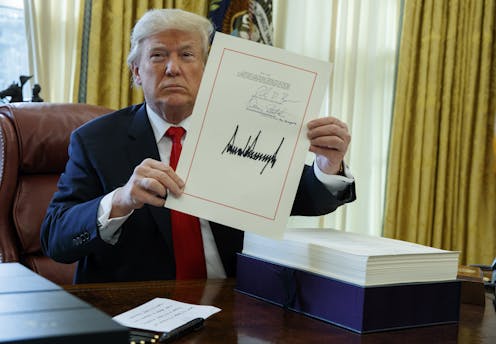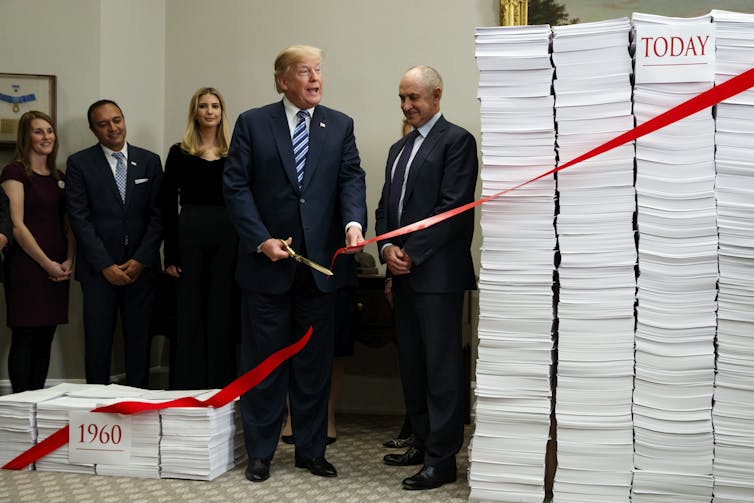Trump’s plans to extend tax cuts and slash red tape will likely spur economic growth − but there’s a
Much of Trump’s 2017 tax law is set to expire at the end of 2025 – failing to extend it would hurt households and the economy.

The economy was one of their top issues as voters went to the polls this year. So what does Donald Trump’s return to the White House – as well as Republican gains in Congress – mean for the U.S. economy?
I followed the election closely, with a keen interest on each candidate’s economic plans. I believe there are two key areas in particular where Trump’s victory could produce economic benefits over the next four years. But there’s also a cost that will have to be paid.
Extending Trump’s 2017 tax law
Let’s start with taxes.
Nearly all of the provisions of the Tax Cuts and Jobs Act of 2017, which Congress passed and Trump signed into law in his first year in office, expire at the end of 2025. If those parts of the law aren’t extended, it would result in a tax hike of about US$4 trillion through 2034. This would impose an additional burden on households coming out of a period of high inflation that resulted in significant hardship for many families – and contributed to Trump’s victory.
Extending the individual income tax cuts would keep marginal tax rates from jumping and lead – relative to letting them expire – to an increase in economic output in the long run. This occurs because lower taxes increase demand for goods and services in the short run. Lower tax rates increase the incentive to work, save and invest, which leads to more hours worked, more capital, increased labor productivity and new business formations in the long run.
The law also improved tax simplicity by doubling the standard deduction. And it promoted fairness by increasing the child tax credit, reducing how many taxpayers are subject to the alternative minimum tax and capping the deduction on state and local income taxes. Not sure how you’d like to tweak that The expiration of these provisions would result in a significant increase in the tax burden on many lower- and middle-income households.
Given that Trump signed the act into law in 2017, I believe it’s a good bet that, at a minimum, he’ll extend the law, which will be much easier with a Republican Congress. And many economists would argue that will be good news for American households and the economy as a whole.
Removing more red tape
More importantly, in my view, are what I expect will be his more business-related policies that should promote innovation, investment and productivity, many of which also relate to the 2017 tax law.
A few of these policies also relate to the same tax law – and so are very likely to be extended or reformed early in Trump’s second term. Two provisions that are set to expire soon are the 20% small-business deduction and a measure that allows for the expensing of equipment such as computers and manufacturing machinery.
The small-business deduction, which allows owners to deduct up to 20% of their share of the company’s income from their individual tax bills, was found to increase employment by 1.2 million jobs a year. It’s also important to ensure that small businesses remain competitive with larger rivals. Allowing businesses to fully expense the cost of equipment has been found to increase economic output by about 5% over the long term.
It’s important to extend these provisions to avoid a large tax increase on small businesses that would reduce job creation and innovation and lead to slower growth and lower living standards.
A related issue is accounting for research and development expenditures. The 2017 tax law actually raised taxes for companies by requiring these expenses be spread over five years, which raises the cost of capital and disincentives investment. Trump has said he would change this so all expenses, including R&D, can be immediately expensed. This should promote economic growth.

More broadly, Trump’s first term in office was characterized by a reduction in red tape as regulatory reform was a major focus of his administration. Research on the economic cost of new regulations suggests the extra burden of regulations during the Trump administration was significantly lower than during the administrations of George W. Bush, Barack Obama and Joe Biden.
Research suggests the U.S. economy remains stifled by heavy-handed and poorly targeted regulations that slow growth and innovation. Trump has promised to further reduce regulations during a second term, so it could lead to solid gains in economic output.
Given the promise of artificial intelligence to increase productivity and growth in the near future, I believe it is more important than ever to ensure that government agency’s set the rules of the game in a fair and efficient manner, without choking off the economic benefits of increased innovation.
Offsetting the costs
But there’s one big caveat to this. Extending those tax cuts will put serious strain on the national debt, which is currently at unsustainable levels.
Since the turn of the century, U.S. debt has increased from $10 trillion to over $35 trillion, and the Congressional Budget Office projects that the debt will increase as a share of GDP from 99% in 2024 to 166% in 2054.
Reforming the tax code to avoid a significant increase in taxes is important, but offsetting the revenue loss with spending cuts will be vital to avoid adding to the debt. Failing to do so would significantly increase the deficit and national debt, and put the nation’s finances on an even more precarious path.
But Trump could go further than simply finding offsets. The start of the new administration is a perfect time, in my view, to create a new fiscal commission to jump-start a bipartisan conversation on sustainable fiscal policy solutions.
John W. Diamond does not work for, consult, own shares in or receive funding from any company or organization that would benefit from this article, and has disclosed no relevant affiliations beyond their academic appointment.
Read These Next
Karoline Leavitt’s White House briefing doublethink is straight out of Orwell’s ‘1984’
A historian analyzes how White House press secretary Karoline Leavitt’s claims about her boss and…
Where the wild things thrive: Finding and protecting nature’s climate change safe havens
Protecting places that are likely to remain cool and moist as global temperatures rise can save wildlife…
Billionaires with $1 salaries – and other legal tax dodges the ultrawealthy use to keep their riches
The richest Americans can largely avoid paying income and other taxes. A new book explains the history.






